By Rob Shaul, Founder
As part of our “continuous improvement” ethic, we’re not afraid to purchase and test new and different gym equipment. We’ll hear about a new piece of equipment, and have something recommended to us, I’ll purchase it and write its use into an upcoming lab rat training cycle, and see how it performs.
Sometimes the new piece of equipment is an obvious bust, and it’ll head to storage immediately after the cycle is completed.
But usually, it’s ending isn’t as quick or dramatic.
The equipment and exercise(s) it’s used for will be “ok” and the equipment will last on our weight room floor for a while. But eventually, I’ll find myself not writing it into our programming cycles, notice that it’s taking up valuable space, and banish it to storage.
Below are the 8 pieces of equipment that didn’t make the cut at MTI.
1. Glute Ham Development (GHD) Machines
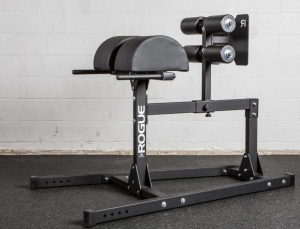 CrossFit made GHD sit-ups all the rage and for several years GHD sit-ups were a common core exercise in our former core training methodology.
CrossFit made GHD sit-ups all the rage and for several years GHD sit-ups were a common core exercise in our former core training methodology.
This exercise got cut when we moved to our Chassis Integrity Theory which dictates core exercises be completed from a standing or kneeling position (mostly) and don’t emphasize flexion.
While CrossFit caused the sale of many GHD machines for the sit-ups, GHD machines were built to build Glutes and Hamstrings. However, in my experience, testing with many different styles of GHD machines, we found teaching athletes how to do a GHD Raise properly to be a major headache. The simple Nordic Hamstring Curl is nearly as good, much easier to teach, and requires no equipment.
2. Reverse Hyper
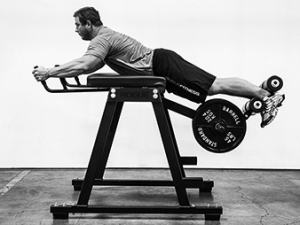 Alpine skiing is quad dominant and to add balance for several years we purposely focused on hamstring work and lute strength work.
Alpine skiing is quad dominant and to add balance for several years we purposely focused on hamstring work and lute strength work.
I’m not sure who invented the Reverse Hyper machine, but I learned about it by reading articles praising its use and effectiveness from Louie Simmons at Westside Barbell in Ohio.
Westside is a famous, champion-producing powerlifting gym and the Reverse Hyper is deployed to build hamstring, glute and low back strength for the heavy back squats and deadlifts in that sport. I bought two of these expensive machines and used them for a summer offseason ski-strength cycle with limited success.
Reverse Hypers were one of those pieces of equipment that I was lukewarm about, and after that initial cycle just didn’t get written into many subsequent training cycles. Eventually, I sold mine to another gym in town.
We still train glutes and hamstrings during our ski cycles, but deploy simple, low weight, high rep Hinge Lifts and Good Mornings with barbells.
3. Rings & TRX Devices
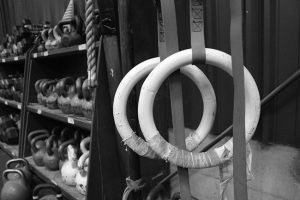 I’ve purchased several sets of rings and TRX-like devices over the years each time thinking I’d use them more than I did. We even have a set currently hung from our tall ceiling some CrossFitters who use the gym to train on their own will use for muscle ups, but that exercise never made it into my programming.
I’ve purchased several sets of rings and TRX-like devices over the years each time thinking I’d use them more than I did. We even have a set currently hung from our tall ceiling some CrossFitters who use the gym to train on their own will use for muscle ups, but that exercise never made it into my programming.
Rings certainly make push ups and dips harder, but quite frankly, regular push ups and bar dips are pretty hard just the way they are. There are also some hard, interesting mid-section exercises using rings and these devices, but they just don’t seem to make it into my programming.
We have several pairs of these and most live in a box up high in the storage area, but still, a couple pair survived hanging from our pull up bars. They can be pushed to the side, well out of the way, and thus haven’t annoyed me enough to remove them.
For bodyweight-only athletes, rings can be used to easily progress many Bodyweight exercises without a weight vest or external loading and TRX has sold a bazillion pairs to military units deployed to austere locations marketing them as a training device for places without gym equipment and offering an option to bodyweight training.
However, as mentioned above, we’ve developed bodyweight-only training methodologies that push athletes beyond high rep push ups, pull ups, sit ups and squats and offer solid progression and variety without rings or any other external piece of equipment.
4. Slosh Bags and Water-Filled PVC Pipes
 I first saw a water-filled piece of 4” PVC reading something from Dan John, and immediately built one for my gym. The “Slosh Pipe” was an interesting curiosity for a couple weeks – as the climbers and mountains guides would come in and try to break each other’s record holding it up overhead. This lasted until one climber failed and dropped on the concrete floor, breaking the end cap, and spilling water all over the place.
I first saw a water-filled piece of 4” PVC reading something from Dan John, and immediately built one for my gym. The “Slosh Pipe” was an interesting curiosity for a couple weeks – as the climbers and mountains guides would come in and try to break each other’s record holding it up overhead. This lasted until one climber failed and dropped on the concrete floor, breaking the end cap, and spilling water all over the place.
Just a a few years ago, in the early development of my Chassis Integrity methodology, I purchased $1,500 worth of PVC “Aqua bags” – duffle bags with handles you’d fill partially with water.
The water in these devices sloshes back and forth, making lifting them unstable and demanding more core stabilization work that lifting a regular sandbag.
That first summer we used Aqua Bags alongside our regular sandbags and other pieces of equipment as we developed and tested our Chassis Integrity exercises. They did okay.
But like the Reverse Hypers, after that initial summer, they lingered on the gym floor and I didn’t write them into subsequent cycles. After they had collected dust and took up space for a month, I drained them all and banished them to a big box the gym storage area … where they continue to collect dust.
5. Medicine Balls and Slam Balls
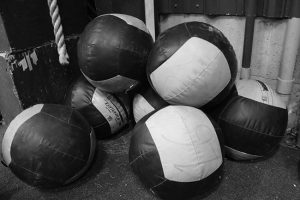 When first outfitting my gym I was sure I needed some of the big mt medicine balls I’d send athletes bouncing their butts off during squats or doing wall balls within the old CrossFit videos … that was until I saw how much they cost. There was just no way I was going to spend $100 per ball.
When first outfitting my gym I was sure I needed some of the big mt medicine balls I’d send athletes bouncing their butts off during squats or doing wall balls within the old CrossFit videos … that was until I saw how much they cost. There was just no way I was going to spend $100 per ball.
Then shopping the “sale” room at Bigger Faster Stronger during a Salt Lake City visit years ago I found a bunch of these balls at fire sale prices – $20/each, and bought several. Soon after I purchased some 25# slam balls.
These have the potential to be great pieces of training equipment, but for whatever reason, they have just never become a regular part of my program design and late this summer, I finally moved them from their shelving unit on the gym floor to the storage area.
Long ago we went away from using the Dynamax balls for squats. Wall Balls went away when we moved from completing garbage reps in our programming.
I even developed a Medicine Ball Complex we used for warm ups every once in a while. But I haven’t programmed it in so long – I’ve forgotten the movements and rep scheme.
One summer I did program medicine ball work for a part of our Freeski Team’s core work – but that only lasted for the one summer.
One problem with medicine balls is many of the exercises require either a wall or a partner. This limits their utility.
Slam Balls are a one-exercise piece of equipment. The ball slam is a great work capacity exercise – but it’s not significantly better than the no-equipment burpee or even simpler: box jump.
Overall, medicine balls and medicine ball exercises have never cracked my programming to become a key piece of equipment for us.
6. Trap Bars
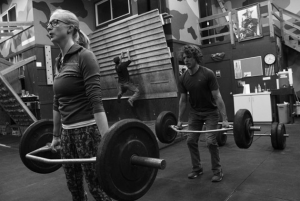 Trap Bars, designed for Trap Bar Dead Lifts, were an early purchase as I equipped my gym a decade ago.
Trap Bars, designed for Trap Bar Dead Lifts, were an early purchase as I equipped my gym a decade ago.
Trap Bar deadlift is a combo squat and deadlift movement, and many coaches find them simpler and especially safer than regular deadlifts and back squats. Because the trap bar deadlift is perceived to be safer than squats and deadlifts, trap bars are used extensively in high school and college weight rooms.
It is especially thought that the trap bar deadlift is much safer for taller athletes, and some trap bars actually have elevated handles to accommodate tall lifter.
In my experience, however, I haven’t found the trap bar deadlift any safer than our Hinge lift, and unlike the barbell, which can be used for multiple exercises and even work capacity, the trap bar is a single-exercise piece of equipment.
Ours are currently still on the weight room floor, but hidden from my view leaning up against the wall behind our pull up bars. I’ll be moving them to the storage area soon.
7. Airdyne or Assault Bike
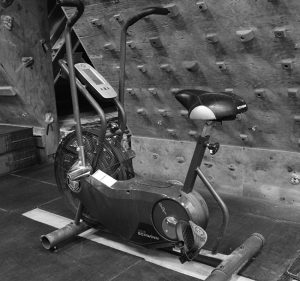 We have one of these and it actually still sits on our weight room floor, in the way. We only have one, and have never used it for hard work capacity intervals or even longer endurance efforts. The most use it’s seen is with injured, recovering athletes who are wearing a cast or brace and can’t run or do step ups.
We have one of these and it actually still sits on our weight room floor, in the way. We only have one, and have never used it for hard work capacity intervals or even longer endurance efforts. The most use it’s seen is with injured, recovering athletes who are wearing a cast or brace and can’t run or do step ups.
I can have them sit on the airdyne and use their arms only for work capacity intervals.
That isn’t to say these things aren’t absolutely killer – they are …. airdyne intervals suck …. but they have just not made it into my programming.
Why? I only have one of them, but also, I’m worried about transfer outside the gym. The primary work capacity mode – when things get dangerous – for our tactical athletes is sprint repeats. Does conditioning completed on an airdyne transfer to sprinting repeats like movement under fire? Somewhat, I’m sure, but at some point doing extensive airdyne work, the athlete quits getting better at repeat shuttle sprints, and just gets better at airdyne intervals. Which, unless you’re competing in some the of airdyne competition, is a “go nowhere” endeavor.
Thus, sprint and shuttle repeats are a primary mode of work capacity training in my programming.
8. Rowing Machines
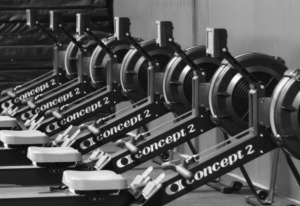 I own four old Concept 2 rowing ergs, and 3 are in the storage area. The forth stands up against the gym wall and I have injured or recovering athletes who can’t do sprints, box jumps, or whatever work capacity event we have planned for that day, row, instead.
I own four old Concept 2 rowing ergs, and 3 are in the storage area. The forth stands up against the gym wall and I have injured or recovering athletes who can’t do sprints, box jumps, or whatever work capacity event we have planned for that day, row, instead.
Luckily, I didn’t have to pay full price for our rowers – I picked them up used for $200 each years ago from a used commercial gym equipment broker in Salt Lake.
Like the airdyne, rowing is killer – especially for the most of us who’ve never rowed before – and it is a great general purpose conditioning and endurance exercise mode.
But, mountain athletes don’t row anywhere in the mountains, and the same is true of tactical athletes on the streets, battlefield or fire grounds.
At some point, doing lots of rowing on the erg stops transferring outside the gym and just gets you better at rowing – which is a dead end for our athlete population.
“Why risk it?” I began to ask myself years ago – and we moved to focus on shuttle sprint repeats and other conditioning exercises which I feel develop work capacity which better transfers outside the gym. Sprinting and shuttle sprints, especially are, by far, is my favorite work capacity mode and have direct transfer outside the gym.
Questions, Comments, Feedback? Email coach@mtntactical.com
You Might Also Like 12 Fundamental Pieces of Gym Equipment